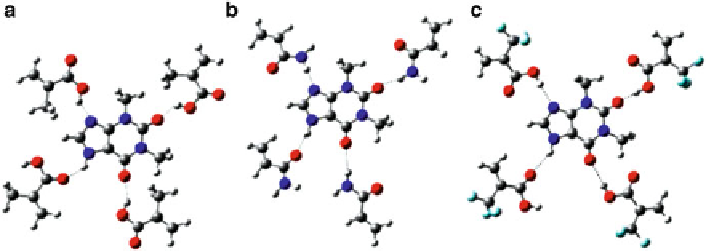Biomedical Engineering Reference
In-Depth Information
Fig. 7 The complex formed between THO and MAA (a), AA (b) and TFMAA (c), respectively
[
67
]. Reproduced with permission
function description for both the electrons and the nuclei at the same time. The nuclei
are heavier and move much more slowly than the electrons, and therefore can be
regarded as stationary while the electronic wave function is computed. By computing
the QM of electronic motion, the energy changes for different chemical processes,
vibrations, and chemical reactions can be understood [
168
].
2.6 Examples of QM Methods Used in MIP Design
Dong et al. [
67
] employed this method to screen monomers using the binding
energy,
E
, of a template molecule and a monomer as a measure of their interac-
tion. In this study THO was chosen as the template molecule, and MAA, AA, and
TFMAA were the functional monomers (Fig.
7
).
The calculation of
D
E
was performed using DFT with the Gaussian 98 software
[
169
]. First, the conformations of THO, MAA, AA, and TFMAA were optimized,
and the energy of the molecules with the optimized conformation was calculated.
Then the energy calculation was applied to the complex formed between THO and
MAA, or AA or TFMAA, respectively. The MIP synthesized using TFMAA as
monomer showed the highest selectivity to THO while the MIP from AA gave the
lowest, as predicted from the calculation of binding energy (
D
D
E
), [Eq. (
2
)].
D
E
¼
E
ð
complex
Þ
E
ð
THO
Þ
E
ð
monomer
Þ:
(2)
Wu et al. [
66
] showed that a similar technique could be employed to determine
the influence of the solvents used as porogen on the affinity and selectivity of MIPs.
The interaction energy values between NAM and MAA were modeled with metha-
nol, acetonitrile, chloroform, and toluene as the porogens. Gaussian 03 [
170
] was
adopted as the software to carry out the simulation, and B3LYP [
147
,
171
] was
selected as the calculation method. B3LYP is a DFT method, which takes electronic
correlation energy into consideration. This provides results of weak interaction
system compared with Hartree-Fock method. The retention factors and selectivity

Search WWH ::

Custom Search